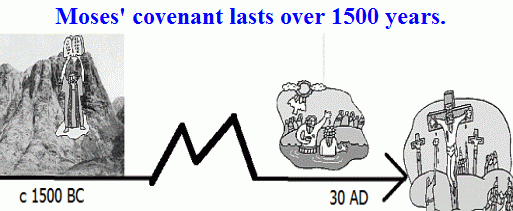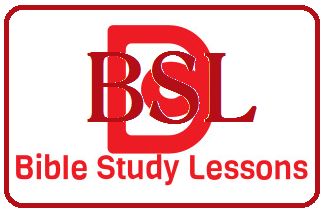There have been controversies down through the ages on what Moses taught, what Jesus taught, and what the apostles taught about morality. I perceive that reading through the historical writings that much of the problem has been that there have been differences of opinions about the covenants of God with man. When did one covenant's laws begin, end, and another covenant's laws begin. This is a series of lessons pointing out that Jesus did not preach against Moses; instead, Jesus accompanied John the Baptist's call for repentance of sins against Moses' Law.

The "Sermon on the Mount" is not just fundamental teachings of the Kingdom of Heaven, it is reconfirmation of laws given through Moses. But someone may ask, "Why does Jesus seem to contrast His teaching with that of the Ten Commandments?"
"Is Jesus not contrasting the perverted oral traditions of the Jews with the true moral pronouncements of the Law?" I believe the answer to this question to be true in this sense: the Pharisees with the scribes were teachers. The Pharisees taught the people by what was called in Hebrew 'שמעתא' "hearing." They would "read" the Law and then make their oral comments. Their comments were called "oral traditions" that actually in many cases negated the intent of the Law.i For example, for the commandment "Honor your father and mother", they had added the "instruction" that one could give any support money needed by the parents for an "offering" to the leaders (Matthew 15:3-6). Jesus accused them, "Thus have ye made the commandment of God of none effect by your tradition."
Jesus is not contrasting His teaching with Moses in the sermon on the mount. He says this plainly for His audience and for us. The Pharisaic sages' reversals of the Law were Jesus' targets as I shall point out below.
The context of Matthew 5 is a portion of the sermon on the mount. Jesus completes the beatitudes and charges his audience to be like salt and to publicly let one's light shine in spite of persecution. Jesus then confirms His teaching on the Law of Moses' commands.
"Think not that I am come to destroy the law, or the prophets: I am not come to destroy, but to fulfil. For verily I say unto you, Till heaven and earth pass, one jot or one tittle shall in no wise pass from the law, till all be fulfilled. Whosoever therefore shall break one of these least commandments, and shall teach men so, he shall be called the least in the kingdom of heaven: but whosoever shall do and teach [them], the same shall be called great in the kingdom of heaven. For I say unto you, That except your righteousness shall exceed [the righteousness] of the scribes and Pharisees, ye shall in no case enter into the kingdom of heaven" (Matthew 5:17-20, KJV).

"I AM NOT COME TO DESTROY"
The Old Testament was not referred to as the "Old Testament" when Jesus was on earth. The first five books were often referred to as "The Law" and the remaining books were known as "The Prophets." Sometimes the Psalms (also called, "The Writings")ii were distinguished from the "Prophets" (Luke 24:44). But when Jesus was using the name "the Law and the Prophets", He was referring to what we call today, "the Old Testament."iii
Jesus asserts that His teaching is not to "destroy" the Old Testament; i.e., meaning to "loosen down" as of a house or tent (2 Corinthians 5:1). "'Fulfil' is to fill full."iv A. T. Robertson, author of Word Pictures in the New Testament, believes that Jesus is strictly referring to fulfilling the part of the Law that pointed to Him as the Messiah and that He did not do anything to the "moral law." Suffice it to say, however, that Jesus is definitely saying that He is not teaching against the Law or the prophets. Neither are His remarks to be construed as doing away with or contradicting the Law as some teachers erroneously indicate.
Jesus finishes His preface with His assertion that one's righteousness MUST "exceed [the righteousness] of the scribes and Pharisees" (Matthew 5:20). Whereas it is true that we think of hypocrisy when we think of Pharisees, nevertheless, the role that the Pharisees proudly held as precious was their elite position of teaching so that they could proselyte Pharisees. It was this role that Jesus was addressing.
DikaiosuneG1343 (righteousness) according to Thayer's Greek Definitions refers to both "a doctrine concerning the way for a man to be approved of God and the life resulting from it." Jesus is talking about the doctrine or teaching of the Pharisees and not just their hypocrisy.
THE PHARISEES' TEACHING ROLE
As Jesus said, "Woe unto you, scribes and Pharisees, hypocrites! for ye compass sea and land to make one proselyte, and when he is made, ye make him twofold more the child of hell than yourselves" (Matthew 23:15). Their oral interpretations were making God's Law null and void (Matthew 15:6). But these interpretations were being inserted in their interpretation of Moses and the Prophets when they were teaching.
This "Pharisee remark" by Jesus cannot be ignored if we are to understand what Jesus is saying in the context of Matthew 5-7. For example, in Matthew 5:43 Jesus quotes "thou shalt hate thine enemy." "This phrase is not in the Leviticus 19:18 passage alluded to, but is in a rabbinical (i.e., Pharisee) inference which Jesus repudiates bluntly."v Jesus presentation has been described as "a more sublime and spiritual explanation and application of God's moral laws to the Jews."vi
In conclusion, when we look at the sermon on the mount we should remember that Jesus is upholding the righteousness of Moses as opposed to that of the religious leaders of His time or even in these days those that pervert the Old Testament.
- Gaylon West
THROW OUT THE LIFELINE
iThe Talmud "sages" (Pharisees) taught that "God made a covenant with Israel only for the sake of that which was transmitted orally." Exhibit 60: Soncino Press 1936 publication of the Babylonian Talmud.
"The Talmud reverses every one of the Ten Commandments, the teachings of Moses and the Prophets..." --"The Pharisees, the Talmud, and Modern Judaism" The Jewish Religion: Its Influence Today by Elizabeth Dilling. http://www.come-and-hear.com/dilling/chapt01.html--
ii"Psalms." Easton's Illustrated Bible Dictionary.
iiiMcDowell, Josh. The New Evidence That Demands a Verdict. Nelson, 1999, pp. 334-335.
ivRobinson's Word Pictures in the New Testament (Matthew 5:17).
vIbid. (Matthew 5:43).
vihttp://www.biblequestions.org/archives/BQAR082.htm
